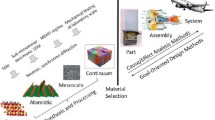Abstract
Microstructure informatics is a critical building block of the integrated computational materials engineering infrastructure. Accelerated design and development of new advanced materials and their successful insertion in engineering practice are largely hindered by the lack of a rigorous mathematical framework for the robust generation of microstructure informatics relevant to the specific application. This paper describes a set of computational protocols that are capable of accelerating significantly the process of building the needed microstructure informatics for a targeted application. These novel protocols have several advantages over the current practice in the field: they allow archival, real-time searches, and quantitative comparisons of different instantiations within large microstructure datasets; they allow for automatic identification and extraction of microstructure features or metrics of interest from very large datasets; they allow for establishment of reliable microstructure-property correlations using objective measures of microstructure; and they provide precise quantitative insights on how the local neighborhood influences the localization of macroscale loading and/or the local evolution of microstructure leading to development of robust, scale-bridging, microstructure-property-processing linkages.
Similar content being viewed by others
References
Integrated Computational Materials Engineering: A Transformational Discipline for Improved Competitiveness and National Security (National Research Council. Committee on Integrated Computational Materials, Washington, D.C., National Academies Press, 2008).
D.T. Fullwood et al., Progress in Materials Science, 55(6) (2010), pp. 477–562.
H. Bunge, Texture Analysis in Materials Science (London, Boston: Butterworths, 1982).
S.M. Schmid et al., Tectonophysics, 78(1–4) (1981), pp. 101–117.
S. Torquato, Random Heterogeneous Materials (New York, Springer-Verlag, 2002).
A.M. Gokhale, Microscopy and Microanalysis, 10(Supplement S02) (2004), pp. 736–737.
B.L. Adams et al., Materials Science Forum Proceedings of the 10th International Conference on Textures of Materials, Part 2, 157–6 (pt 1) (1994), pp. 287–294.
D.T. Fullwood et al., Acta Materialia, 56(5) (2008), pp. 942–948.
S.R. Niezgoda, “Stochastic Representation of Microstructure via Higher-Order Statistics: Theory and Application” (Ph.D. dissertation, Drexel University, Philadelphia, PA, 2010).
D. Blavette et al., Nature, 363(6428) (1993), pp. 432–435.
E. Maire et al., Advanced Engineering Materials, 3(8) (2001), pp. 539–546.
H.N. Chapman et al., J. Opt. Soc. Am. A, 23(5) (2001), pp. 1179–1200.
S.R. Niezgoda and S.R. Kalidindi, CMC: Computers, Materials, & Continua, 14(2) (2009), pp. 79–89.
P.V.C. Hough, “Method and Means for Recognizing Complex Patterns,” U.S. patent 3,069,654 (1962).
P. Kierkegaard, Machine Vision and Applications, 5(4) (1992), pp. 249–263.
D.H. Ballard, Pattern Recognition, 13(2) (1981), pp. 111–122.
B. Lu and S. Torquato, Physical Review A, 45(2) (1992), p. 922.
V. Sundararaghavan and N. Zabaras, Acta Materialia, 52(14) (2004), pp. 4111–4119.
V. Sundararaghavan and N. Zabaras, Comp. Mater. Science, 32 (2005), pp. 223–239.
H.K.D.H. Bhadeshia, Statistical Analysis and Data Mining, 1(5) (2009), pp. 296–305.
S.R. Kalidindi et al., CMC: Computers, Materials, & Continua, 17(2) (2010), pp. 103–126.
T. Fast et al., Acta Materialia, 59(2) (2011), pp. 699–707.
G. Landi et al., Acta Materialia, 58(7) (2010), pp. 2716–2725.
E. Kröner, Modeling Small Deformation in Polycrystals, ed. J. Gittus and J. Zarka (New York, Elsevier, 1986), pp. 229–291.
G. Milton, The Theory of Composites (Cambridge, MA: Cambridge University Press, 2002).
C.L. Nikias and A.P. Petropulu, Higher-order Spectra Analysis: A Nonlinear Signal Processing Framework (Englewood Cliffs, NJ: PTR Prentice Hall, 1993).
Author information
Authors and Affiliations
Corresponding author
Rights and permissions
About this article
Cite this article
Kalidindi, S.R., Niezgoda, S.R. & Salem, A.A. Microstructure informatics using higher-order statistics and efficient data-mining protocols. JOM 63, 34–41 (2011). https://doi.org/10.1007/s11837-011-0057-7
Published:
Issue Date:
DOI: https://doi.org/10.1007/s11837-011-0057-7




